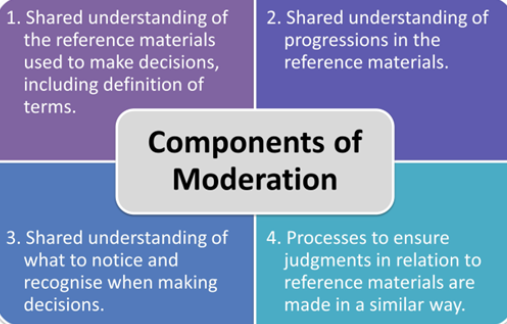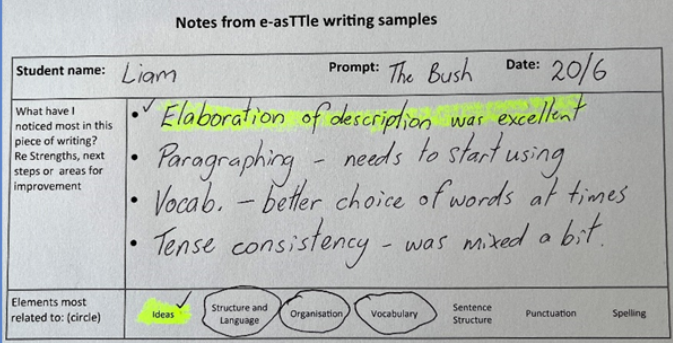e-asTTle script marking - what’s the point?
By Garry Taylor on July 17, 2023 in Assessment tools
Garry offers 8 tips to help you get the best out of e-asTTle script marking in the most efficient and professional way possible.
Our e-asTTle team often get asked about the best way of going about marking and how to get the best out of it. We make no secret that the marking of e-asTTle does take time and effort. We also think it is worth it. Marking e-asTTle scripts is invaluable. You build your knowledge and gain insights about your learners and the process. Below are some tips to help you get the best out of the tool in the most efficient and professional way possible.
Understand the purpose
It’s important that your school is clear about the purpose and rationale for using the tool. From my perspective, it provides an opportunity for students to use and show their repertoire of independent writing skills a couple of times a year. e-asTTle scripts can provide a clear insight into the patterns of writing behaviour students are exhibiting, especially when combined with what a teacher already knows about the student’s writing abilities. You can analyse the data from this activity for a variety of purposes. Focus on student and teacher first, with the other layers of analysis quite transparent.
Don’t do it too often
The writing tool can identify short and long-term goals for students and/or groups of students. This means there is no need to use the tool too often. A couple of times a year is sensible. This not only provides a sensible amount of information for supporting progress in the following months.
A gap of at least six months between assessments also gives time for students to make observable progress against the rubrics. Remember that each rubric only has six or seven stages of development described for ten years of schooling (Years 1 to 10). So movement in every element, for every script, is highly unlikely. If you test too often, progress will be harder to observe. Testing only a couple of times a year is a more sensible approach.
Writing moderation
It’s time to think differently about moderation. We have all spent enough time sitting around trying to mark a single script together, and generally agreeing to disagree on the difficult judgments. It’s our belief that time is better spent knowing the tool intimately so there is a shared understanding of the progressions and marking approach that is required. We use a model of moderation developed by Mitchell and Poskitt.

This uses an approach where the focus is on:
developing shared understanding of the tool
the progressions within the tool (rubrics and exemplars for e-asTTle writing)
what to notice and recognise (during the marking process) and,
what systems should be in place to support the judgment process (marking).
We feel the time spent on really getting to know and understand the tools and their related resources is the best form of moderation. We feel it really does develop consistency in the marking process.
Standardisation of administration
Administering the assessment in a standardised way provides the best opportunity to make valid interpretations and comparisons to external reference points such as means and expectations. For e-asTTle writing, this means following the administration guidelines for the writing tool. In general, this means oral brainstorms only (don’t leave ideas on the board!), no dictionaries, thesauruses or word cards, and completing the assessment within a forty-minute time period.
For some students, accommodations are available and recommended. This can mean more time, larger print for the prompt, a reader/writer or something else. Please take these accommodations into account when interpreting and comparing the student results. For example, a reader/writer in writing potentially makes it difficult to mark elements such as spelling, organisation, and punctuation.
Mark your own students
I am in no doubt the most benefit gained through the e-asTTle writing is by marking the scripts of the students you teach. This is where the real value in the process is found. What you see and notice from scripts, for individuals and across the class, offers new ideas and perspectives of what needs to be focussed on, and how improvement in writing can be made.
I have occasionally been asked if spreading the student scripts across teachers is a good idea. The idea is to help improve consistency between classes. This is often borne from concerns about discrepancies in marking within the staff. If there are concerns about marking inconsistency within the staff, you should address the marking concerns head-on. Spreading the scripts across teachers will not solve the problem. It just hides it!
Make good use of the data
If you are going to the effort of using e-asTTle writing, it needs to add value to your school’s insights into writing. This means taking time to make sense of what you have noticed and recognised from individuals, classes, year groups and across the school. Questions which support this process include:
What are the things you have noticed the most in the script/s? (individual, group)
What highlights and successes have you seen? (individual, group, cohort)
What are some quick wins? (individual, group)
What patterns and trends have you identified across the students? (group, cohort)
What progress has been made since the last assessment? (individual, group, cohort)
What specific foci need to be a priority? (individual, group, cohort)
One of the best tools for supporting this process is the student notes tool. We developed this as a simple way of summarising what you have noticed and identified while marking student scripts. It allows for some good things to be noticed, some priorities to be noted, and some trends to be identified across students. For example, if ‘consider choice of words’ has been written for 18 out of 25 students, it is a clear indication that students need support with their vocabulary choice.
An example of the student note tool in use can be seen below. It could be done just as easily in electronic form in a table or spreadsheet.

The elements within the marking rubric are linked by circling those that relate to the bullet points above. Only four bullet points have been provided on the form because it is necessary to prioritise the needs for some students. Students should not feel bombarded with too much information. Typically, a highlight or two and a maximum of three things for future focus.
Limited value for students at the lowest levels
The e-asTTle writing manual clearly states that the tool has been developed for Year 1-10 students. Students who score in the lowest category for every element are not well-targeted by this assessment. Decisions on which students should take the writing assessment are entirely a school one. Some schools have not decided to use the tool at the very early levels of schooling. Others think all students that can be considered to be a ‘writer’ should take the assessment, knowing the analysis of the script for the lowest performing students will be of limited use. The rationale for this is that the initial script provides some baseline data to compare against in the future and provide a sense of progress.
Share reports and notes with students
For most students sharing the Individual Learning Pathway and notes from writing is appropriate and important, particularly if ongoing improvement and progress are the focus. Sharing information with students in a learning-focused conversation supports an assessment for learning approach. It increases student agency as they feel more involved and connected to their own learning. Of course, sensitivity and tact are required with some students. Keep in mind that the conversations should always support and promote further learning.
This does not need to be a time-intensive activity. I distinctly remember observing a teacher one day that talked to the whole class about what she had seen across all their scripts. She asked them to look at their own scripts for those things and then identify other possible areas for improvement. While they did this, she talked with individuals about specific aspects of their writing that she had noticed. The students were engaged, focused and interested in their own development.
References
Ministry of Education. Administration guidelines and instructions for e-asTTle writing.
We have a range of options available to support you with e-asTTle. Contact Garry today to learn more.
Other articles you might like
There are a number of reasons why your choice of e-asTTle prompt is important. I have outlined 9 of these below. I know from my work with schools that many of you do have questions regarding this assessment tool.
We are living in times of changing education policy.
A few years ago I visited a school for the first time and a teacher asked what my job was. I told her that I was a facilitator and a lot of my work in schools was supporting teachers and students with assessment for learning. “Ugh… assessment,’ she replied. “If they would just let us get on with teaching!” It was a wonderfully honest response, which demonstrated to me how assessment can start to be viewed as a required task which sits separately to teaching and learning, rather than the bridge between teaching and learning.
